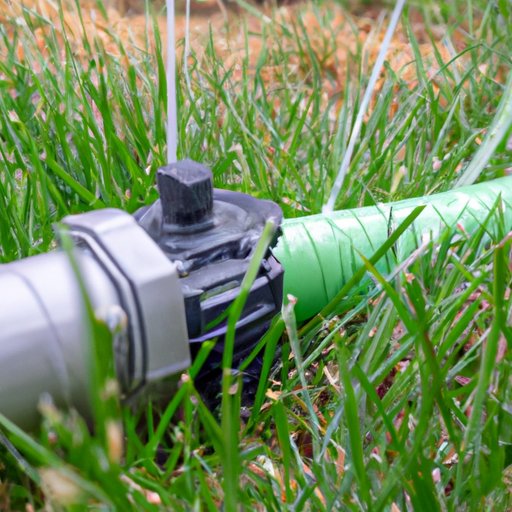I. Introduction
Irrigation is an essential component of maintaining a healthy lawn or garden. But how much does irrigation cost, and what factors should you consider when planning to install an irrigation system? This article will provide a comprehensive guide to understanding the true cost of irrigation and help you make informed decisions about installing and maintaining an irrigation system for your lawn or garden.
II. Understanding the Cost of Irrigation: A Comprehensive Guide
Irrigation is the process of applying water to plants or soil to maintain or promote their growth. There are several different types of irrigation systems available, including drip irrigation, sprinkler systems, and soaker hoses.
Each type of irrigation system has its pros and cons. For example, drip irrigation is excellent for water conservation but may not be as effective for some types of plants. Sprinkler systems are versatile, but they can be costly and use more water than drip irrigation. Soaker hoses are an affordable option but may not distribute water evenly.
The components of an irrigation system include pipes, valves, backflow preventers, sprinkler heads, and timers. Each component plays a crucial role in the system’s performance and water distribution.
Factors that affect the cost of irrigation include the size of the lawn or garden, the type of soil, the climate, and the availability of water. It’s essential to consider each of these factors when planning and budgeting for an irrigation system.
III. The True Cost of Irrigation: Breaking Down the Numbers
The cost of irrigation can vary widely depending on several factors, including the type of system, the size of the lawn or garden, the availability of water, and the contractor’s price. In general, the upfront costs of purchasing and installing an irrigation system can range from $2,500 to $7,500 or more, depending on the system’s size and complexity.
The ongoing costs of operating and maintaining an irrigation system can also add up over time. These costs include water bills, electricity bills, repairs, and winterization. The cost of maintaining an irrigation system can range from $100 to $1,000 per year, depending on the size and complexity of the system and the contractor’s price.
While some homeowners may choose to install an irrigation system themselves to save money, professional installation is generally recommended. Hiring a professional contractor can ensure that the system is installed and maintained correctly, leading to better performance and cost savings over time.
IV. Saving Water and Money: The Benefits of Installing an Irrigation System
Although the cost of installing an irrigation system may seem daunting, it’s essential to consider the long-term benefits of efficient irrigation. Properly installed and maintained irrigation systems can help save water and money over time.
Efficient irrigation systems can help reduce water waste by distributing water evenly and at the right time, leading to healthier plants and lower water bills. Irrigation systems can also help reduce runoff and soil erosion, leading to healthier soil and fewer environmental problems.
For example, suppose a homeowner with a 1,000 square foot lawn installs a properly designed and maintained irrigation system. In that case, they can save up to 57,000 gallons of water per year, leading to significant cost savings on their water bill.
V. Factors That Affect the Cost of Irrigation: How to Get the Best Value for Your Money
Several different factors can affect the cost of irrigation, including the size of the lawn or garden, the type of soil, the climate, and the contractor’s price. To get the best value for your money, it’s essential to work with a reputable contractor and select the right components for your system.
For example, selecting drought-resistant plants can help reduce the amount of water needed for irrigation, leading to significant cost savings over time. Installing a rain sensor can also help reduce water waste by automatically turning off the irrigation system during rain events.
VI. Irrigation 101: An In-Depth Look at the Different Costs Involved
When planning to install an irrigation system, there are several different costs to consider. For example, pipes, valves, backflow preventers, sprinkler heads, and timers are all essential components of an irrigation system and can vary in cost depending on the size and complexity of the system.
The cost of maintaining an irrigation system can also vary depending on the contractor’s price, repairs needed, and winterization services required. Each of these costs should be carefully considered when budgeting for an irrigation system.
An example breakdown of the cost of components for a 1,000 square foot lawn irrigation system may include:
- Pipes and fittings: $300
- Valves: $100-$250
- Backflow preventer: $100-$200
- Sprinkler heads: $80-$100 per head
- Timers: $100-$200
VII. Conclusion
Installing an irrigation system can be a significant investment, but one that can lead to significant cost savings and environmental benefits over time. By understanding the true cost of irrigation, including upfront installation costs, ongoing maintenance, and water savings, homeowners can make informed decisions about installing and maintaining an irrigation system for their lawn or garden. Remember to choose the right components for your system, work with a reputable contractor, and consider factors like water-saving techniques and drought-resistant plants when planning your irrigation system.
If you’re interested in installing an irrigation system, consider reaching out to a trusted contractor for a consultation and start enjoying the benefits of efficient irrigation today.
(Note: Is this article not meeting your expectations? Do you have knowledge or insights to share? Unlock new opportunities and expand your reach by joining our authors team. Click Registration to join us and share your expertise with our readers.)
